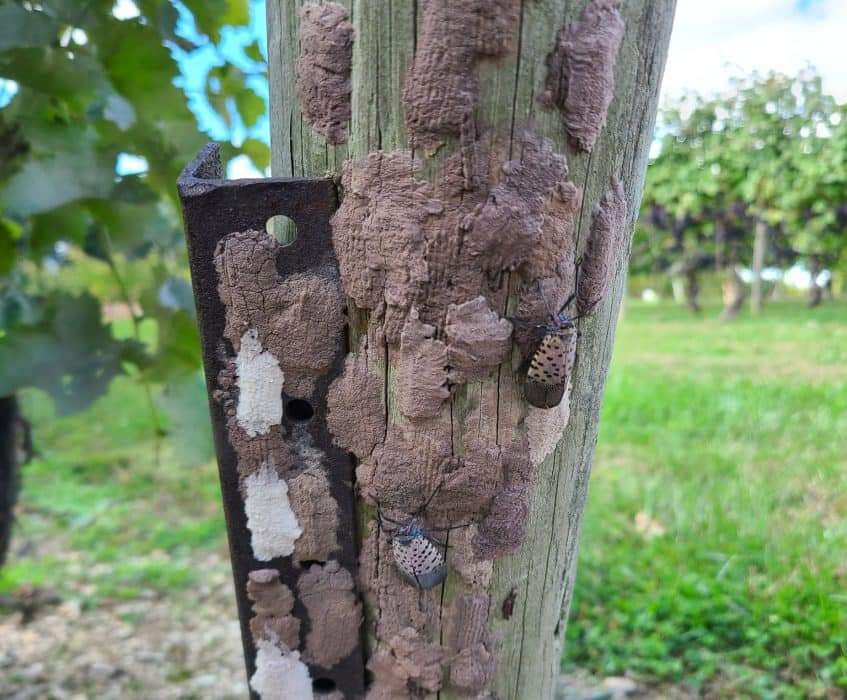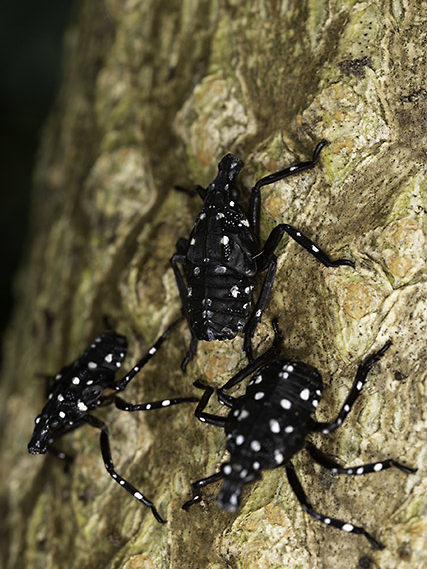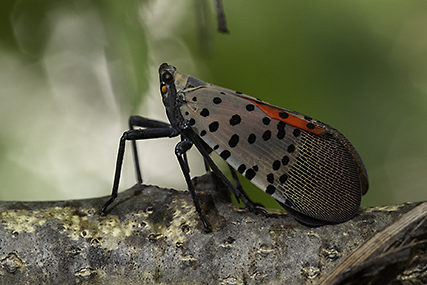By now you have likely seen the invasive bug known as the Spotted Lantern fly or the Chinese Lantern Fly. The lantern fly is native to China, Taiwan, and Vietnam; it has since spread to South Korea in 2004, Japan in 2009, and to the US in 2014. If you live in an affected area like New Jersey or Pennsylvania, you may already have an understanding of how annoying this bug has become. The bug itself is not a type of fly at all; it’s actually a plant hopper. The lantern fly has two sets of wings when it reaches adulthood, but it is a poor flier. The spotted lantern fly in large numbers use their piercing mouths to reach through the bark to feed on the phloem tissues of the tree leaving wounds that ooze, this eventually leads to parts of the tree to die. While the lantern fly doesn’t bite and does not have the ability to, it feeds on 70 species of plants. The bug feeds mainly on the tree of heaven (which is another invasive tree from Asia), however it damages many of our other important fruit bearing trees. A 2020 study conducted by Penn State estimated that yearly damage to the state of Pennsylvania’s economy by the SLF could be upwards of $554 million dollars and result in 5,000 lost jobs. While the lantern fly is becoming established in New Jersey and other areas, there are things we can do to control their populations. As an invasive species they unfortunately have a kill order on them as they don’t have natural predators to keep their populations in check.
How did they get here?
The spotted lantern fly made its trip over to the United States in 2014 first landing in Berks County, Pennsylvania. There’s a theory that the lantern fly or “SLF ” came here in a shipping container with egg masses on a shipment of paving stones, later they hatched in the spring and set up shop for your neighborhood. As of the writing of this article the lantern fly can be found in 12 US states; these states are: Pennsylvania, New Jersey, New York, Connecticut, Ohio, Delaware, Indiana, Maryland, Massachusetts, North Carolina, Virginia, and West Virginia.
Why are they an issue?
Damage to Agriculture
Besides damaging our fruit bearing trees, (including hops and grapes, our wine and beer!) The lantern fly is playing a part in killing livelihoods on farms. Farmers on orchards are now dealing with trees producing less fruit, and in return having less profits resulting in job losses across the board. Lantern fly feeding damages plants to a point that they get stressed, produce less fruit and in some cases actually die. Some growers of grapes are not just concerned with losing some vines and fruit they are worried about losing entire vineyards with the lantern fly. The lantern fly is known to feed on many types of trees, including: birch, willows, walnut, maple, etc. There are concerns about the timber industry being affected.
If you see lantern flies feeding on your property consider contacting a tree care specialist
They leave “Honeydew”
We didn’t even get to the best (worst) part, while the lantern fly feeds on your tree they quickly need to get rid of waste. They do this by excreting a sugary substance called “honeydew.” Just to be clear, honeydew is a liquid and is as you guessed it their poop. If you happen to be standing under a tree with them feeding, expect to get this “honeydew” literally raining down on you; now that doesn’t sound too sweet.
Honeydew creates more damage
The honeydew drips down the trunk of the tree or falls onto the leaves of other nearby plant life and forms a black sooty mold. This black sooty mold gives off a vinegar smell, while the mold is purely cosmetic on plants it can block sunlight disrupting photosynthesis and kill the leaves. The mold fortunately can be washed off with a mild soap and warm water; edible vegetation is also fine after cleaning. With the lantern fly around this black sooty mold can be found anywhere, like the surface of your car. If you have kids around keep in mind that honeydew attracts ants, bees and wasps to your yard; this potentially brings hives to your yard.
They are a pest
If you live in an affected area you’ll soon realize how annoying the SLF can be. Lantern flies walk everywhere and crawl on any surface then hop off gliding to their next hang out spot. Expect the lantern fly to glide onto you and everything in between. Lantern flies are fortunately just annoying to humans and they don’t physically harm or bite you or your dogs and pets, but they make the outdoors less enjoyable.
They don’t have a natural predator
The biggest issue with the Spotted Lantern fly, is that it is invasive and does not have a predator here. There’s very few animals that will eat them. I have heard of a chipmunk and the praying mantis eating lantern flies. Chickens which are known to eat anything, absolutely anything will not touch the spotted lantern fly. Without a predator the SLF has an unchecked population. One of the many reasons that birds and other animals avoid eating them has to do with their spots and colors. In the animal kingdom bright colors like the lantern flies’ red spots denote that they are poisonous just like the bright colors of some frogs and snakes. The spotted lantern fly is not poisonous to animals. Scientists hope that in time our native animals will come to realize that the lantern fly is in fact edible.
Life Cycles
The spotted lantern fly has four stages of life: eggs, two stages of nymphs, both an early and late stage, and their final stage is an adult.
Egg Masses

Adult lantern flies lay their eggs in September through December, they are laid in masses on smooth surfaces usually close by where they feed. Often these egg masses are found on trunks of trees, sometimes they can be found on concrete surfaces. Lantern Fly egg masses, about an inch long, often look like narrow patches of mud as they are covered in a glue like substance. It is at this stage that it is most important to destroy the eggs and prevent new lantern flies. A female lantern fly lays up to two egg masses with each mass containing 30-50 eggs. As time goes on the mud/glue-like covering comes off the eggs and exposes them, at this point they look like small seeds. Scrapping these egg masses off and destroying them is an essential step for controlling their populations. Keep in mind that killing just one bug can prevent 100 additional lantern flies. Adult lantern flies die in the winter but their eggs survive the season.
Early nymph stage (Early instar)

The early nymph stage is when they begin to damage plants and feed just as adults do, their appearance is black with bright white spots, at this stage they jump and don’t have wings. Early stage nymphs start to appear in May through July and are about ¼ inch in size.
Late Stage Nymph (fourth instar)

The late stage nymph has grown to ½ crawling everywhere and feeding, they don’t have wings just yet and continue to jump to avoid danger. Their appearance has changed to a bright red, accompanied with black stripes and white spots.
Adult Stage

Adult Lantern flies have been taking over many areas in New Jersey, more so this summer in 2022 where they previously were not seen the year before. Take a walk on New Jersey boardwalks in areas like Spring Lake and you’ll find that war has been declared on the lantern fly with their carcasses everywhere. Adult Lantern Flies have a life cycle of up to 1 year with harsh winters in the United States the lifespan is around five months (July – December) Pregnant female lantern flies have larger yellow in appearance abdomens, so killing a pregnant lantern fly in turn prevents 50 or so lantern flies.
The Spotted Lantern Fly in NJ
In New Jersey the Lantern Fly has been thriving thanks to the produce that is produced here. The Garden State has allowed the lantern fly to thrive on the state’s trees, blueberries, vineyards, and everything in between. The lantern fly has been found in the suburbs, beach towns, hiking trails and hordes of them have been found in large cities like Jersey City.
How have they spread?
With the Spotted Lantern Fly first arriving in Pennsylvania it was only a matter of time before the nuisance made its way over to New Jersey. While the Lantern fly is unable to actually fly it has been successful in hitching a ride like other bugs. The lantern fly is able to lay eggs just about anywhere, this includes the wheel wells of cars, and anywhere else. Unknowingly delivering the lanterns’ fly eggs is what has led to its spread across the tri-state.
How to get rid of them
There are quite a few effective ways to get rid of the lantern fly, one of which is “just stomp them.” At best a passive strategy to prevent the annoying bug from damaging your plants, build traps and if you don’t own a farm or orchard avoid stocking your spaces with the bugs favorite source of food. Below are some ways to kill them; stomp them, chemically burn them, drown them, starve them, electrocute them, and even shoot them.
Beauveria bassiana
Beauveria bassiana is a native fungus in North America, and has shown success in killing the spotted lantern fly and other insects. The fungus is harmless to humans. When the lantern fly comes into contact with the fungus white spore attach themselves to the insect and spread throughout the outside of the insect, covering them in white spores. With large populations of the lantern fly coming in contact with each other the chance of continued transmission is high. The fungus is sprayed into highly infected areas. The application of this biopesticide is still being tested but has shown very promising results.
Neem oil
Neem oil is a natural fungicide that kills the lantern fly by essentially starving them, making them unable to eat. Neem oil can be purchased and works by directly spraying the product onto the lantern fly. Neem oil is a common staple in organic gardens so it is safe to use around plants, trees, and produce.
White vinegar
This one is a tuff one, while vinegar has been hailed for cleaning everything as of lately, it doesn’t fix everything. Plenty of people have claimed that vinegar has been effective against lantern flies and killing them on contact. It is suggested to not dilute the vinegar in this case, but be warned spraying vinegar in your yard or garden has consequences. Vinegar is known to even kill weeds, so use this sparingly as white vinegar can kill some common plants .
Dawn in a Spray bottle
Another common household item that we’ve discussed for use with rodents in the garden is dawn dish soap. So once again Dawn dish soap has been called forward to fight on the front lines. Mix 1 part dawn and 1 part water and spray onto the hordes of lantern flies, the sticky soapy solution does a great job at what is essentially drowning them.
Lantern Fly Target Practice and Hunting
I mentioned you can shoot them, for those who haven’t heard of the Bug-a-salt I highly recommend picking one up. This amazing little gadget was designed to be a much more fun version of a fly swatter. This bad boy works like a shotgun, but instead of lead shot it uses table salt. Line up the sights, pull the trigger and watch the lantern fly get obliterated. Happy hunting and pick one up now! Also, we’ve mentioned before that almost everyone is calling to “stomp” the bugs out, but you can also use electric fly swatters which can be found anywhere from $7 to $10 at your local hardware store.
- Bug-A-Salt – $49.99
- Black Flag Indoor and Outdoor Insect Racket Zapper – $9.99
Prevent Lantern Flies
This one is easier said than done, but this involves a multipronged approach. The first step happens in the fall and winter, checking trees, rocks, and other landscape features for egg masses on your property and destroying them. Once the spotted lantern fly becomes prevalent again, ensure that you’re not stocking the pantry. Lantern Flies are incredibly hungry to feast on their favorite tree, the tree of heaven. The tree of heaven is another invasive species that has become common across North America. Both the spotted lantern fly and the tree of heaven are both indigenous to China and parts of Asia. Some scientists believe that the lantern fly is able to thrive here because the tree is here. Some suggest removing the tree all together from your property. If you have fruit bearing trees, you may also want to consider removing that food source as well.
Make traps

The lantern fly feeds by crawling up the trunks of trees so we’ve seen some ingenious ways to get them on glue traps as they climb the trees to feed. Take a look at some of the traps that some of New Jersey’s local orchards and wineries have put together. Wrapping a glue trap around the trunk of the tree while covering the trap with netting and chicken wire helps prevent birds and other desirable insects from getting into the glue traps.
